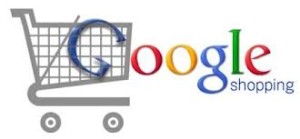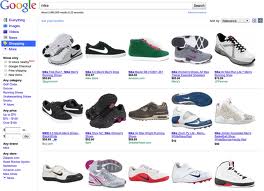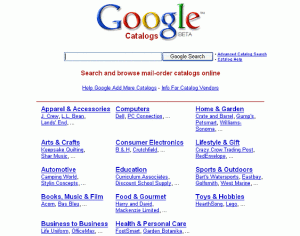Google Shopping: From Froogle to Scroogle
 British consumers spend an average of £1,083 a year on online shopping, and they’re not the only ones in the world who have taken to the internet to get their retail kicks. With ecommerce a booming business, one can easily understand how Google might want to get involved on the scene with its Google Shopping service.
British consumers spend an average of £1,083 a year on online shopping, and they’re not the only ones in the world who have taken to the internet to get their retail kicks. With ecommerce a booming business, one can easily understand how Google might want to get involved on the scene with its Google Shopping service.
Google Shopping started out under the name of Froogle in 2002, and was created by Craig Nevill-Manning. It launched as a price comparison website with a twist. Throughout its history, it was known as Froogle, Google Product Search, and finally Google Shopping. The name Froogle was a pun on the word “frugal” and Google but was dropped when its team feared the joke may be lost on their international market and potential users could be too confused about the product to even give it a chance.
Unlike the other market comparison services we see online today, Google’s results were determined after it indexed the web with similar technology as the one used for the search engine. Companies did not pay to have their products featured, they could submit them for free through the Google Merchant Center. As such the results were not influenced by who had the deepest pockets but were an honest survey of the market. Google Shopping was funded like all the other services in the Google portfolio, by AdSense revenue.
 However, in 2012 Google announced that companies could not expect to continue to have their products listed in its results for free, and now a fee will be required to be present on the index. Moreover, their position in the search results would be determined both by the relevance of the product, and the amount of money the company paid Google to have it featured on Google Shopping. The announcement caused an outrage when it hit the news, with smaller companies showing concern that they would basically be priced out of the service by the big guns who could afford to allocate more money for their marketing budgets. Microsoft’s Bing didn’t lose much time in jumping on the criticism bandwagon, and invited disgruntled Google Shopping users over to Bing Shopping instead through a campaign called “Scroogle”.
However, in 2012 Google announced that companies could not expect to continue to have their products listed in its results for free, and now a fee will be required to be present on the index. Moreover, their position in the search results would be determined both by the relevance of the product, and the amount of money the company paid Google to have it featured on Google Shopping. The announcement caused an outrage when it hit the news, with smaller companies showing concern that they would basically be priced out of the service by the big guns who could afford to allocate more money for their marketing budgets. Microsoft’s Bing didn’t lose much time in jumping on the criticism bandwagon, and invited disgruntled Google Shopping users over to Bing Shopping instead through a campaign called “Scroogle”.
Google Shopping’s vice-president of product management Sameer Samat defended the move. He said: “This is about delivering the best answers for people searching for products and helping connect merchants with the right customers.” Google has clearly performed a U-turn on the subject of paid inclusion, as they were vocally against it a few years back. At Froogle’s IPO listing in 2004, a statement was made which included their views on the subject and why Froogle was better than its competitors: “Because we do not charge merchants for inclusion in Froogle, our users can browse product categories or conduct product searches with confidence that the results we provide are relevant and unbiased.”
Google explained its change of mind in a blog post by saying that getting companies to pay to have their products listed will bring positive changes to the service. A commercial relationship between two parties will emphasise the fact that products featured on Google Shopping are reliable and trustworthy, and will encourage the sellers to update their product descriptions more often and make sure the information is correct. By making the business relationship official, the new Google Shopping will encourage all parties to act differently and take responsibility for their actions.
 Either than making users pay to have their products included in search results, not many updates have been made to Google Shopping. The company revealed that Google Catalogs will be integrated with the shopping service in the future, in order to offer online shoppers a more comprehensive experience. Google Catalogs is an application for tablet computers that gives users access to catalogs from big retail names in the fields of fashion, jewellery, interior design and gifts. Some well know brands such as Bloomingdale’s, Macy’s, Tory Burch, Ralph Lauren, Anthropologie and Sephora currently use the service to have their catalogs sent out. The service is free at both ends, with users only requiring a Gmail address to browse through the collections, but this might change with the impending integration. There is no known date for the merger yet.
Either than making users pay to have their products included in search results, not many updates have been made to Google Shopping. The company revealed that Google Catalogs will be integrated with the shopping service in the future, in order to offer online shoppers a more comprehensive experience. Google Catalogs is an application for tablet computers that gives users access to catalogs from big retail names in the fields of fashion, jewellery, interior design and gifts. Some well know brands such as Bloomingdale’s, Macy’s, Tory Burch, Ralph Lauren, Anthropologie and Sephora currently use the service to have their catalogs sent out. The service is free at both ends, with users only requiring a Gmail address to browse through the collections, but this might change with the impending integration. There is no known date for the merger yet.
